Michéle Samarya-Timm, a registered environmental health specialist with the Somerset County Department of Health in New Jersey (represent) writes:
I roasted my first turkey as a teenager, long before I was smitten with public health as a career, and ages before I really learned to cook. I thought it was easy, especially since the pop-up timer told me dinner was ready. That bird –  raw on the inside and burnt on the outside—looked okay to us. That meal was scarfed down by a group of very hungry – and very poor – college students. We knew nothing of food safety, and probably didn’t care.
raw on the inside and burnt on the outside—looked okay to us. That meal was scarfed down by a group of very hungry – and very poor – college students. We knew nothing of food safety, and probably didn’t care.
It was my first encounter with a pop-up timer. Perfect for the inexperienced cook, right? When the plunger pops the turkey is done, and safe to eat. Or is it? Was that experience unique?
Since a pop-up timer is embedded in 30 million of the 46 million turkeys Americans will be eating this holiday, I sought to be a little more informed.  Here’s what I found:
Here’s what I found:
The pop-up timer found in turkey normally has four parts:
• The outer case (typically white or light blue)
• The little stick that pops up (typically red)
• A spring
• A blob of soft metal at the tip
The soft metal at the tip is solid at room temperature and turns to a liquid (melts) at about 185 degrees Fahrenheit . When the metal turns to a liquid, it frees the end of the red stick that had been trapped in the metal. The spring pops the red stick up and presumably the turkey is done.
Pop-up timers are thought to be relatively fool-proof because they are binary – a popped plunger means “Yes the turkey is done” and an unpopped plunger means “Nope, keep cooking.” But as with anything, this is only true under optimal conditions. Since my first turkey experience, I’ve had pop-up thermometers pop up too soon or not at all, fall apart and even disappear.
While researching this, a colleague told me Butterball turkeys do not have pop-up timers this year. Turns out, they never did. A pleasant representative  at the Butterball Turkey Talk line explained. The placement of a pop-up timer is usually mechanical. This mechanical placement of the pop-up is temperamental – depending on the machines and the turkey placement (they’re slippery when raw!) — so breast, leg or other body parts may be pierced. Variations in the pop-up placement can affect pop-up timing, and presumed temperature. White meat (done at 165ºF-170ºF) cooks quicker than dark meat (where 180ºF is recommended). So instead of including a maybe-not-so-accurate thermometer, Butterball recommends using a probe thermometer to assure proper cooking. The U.S. Department of Agriculture’s meat and poultry hotline, and the Ask Karen online chat had similar information. A pop-up timer is calculated to pop when the breast meat measures about 180 degrees, which is when the leg and thigh area is most likely at the 165 degree temperature. Although pop-up timers are accurate to +/- 2ºF, they recommend verifying temperature of your bird with a thermometer that gives a numeric reading.
at the Butterball Turkey Talk line explained. The placement of a pop-up timer is usually mechanical. This mechanical placement of the pop-up is temperamental – depending on the machines and the turkey placement (they’re slippery when raw!) — so breast, leg or other body parts may be pierced. Variations in the pop-up placement can affect pop-up timing, and presumed temperature. White meat (done at 165ºF-170ºF) cooks quicker than dark meat (where 180ºF is recommended). So instead of including a maybe-not-so-accurate thermometer, Butterball recommends using a probe thermometer to assure proper cooking. The U.S. Department of Agriculture’s meat and poultry hotline, and the Ask Karen online chat had similar information. A pop-up timer is calculated to pop when the breast meat measures about 180 degrees, which is when the leg and thigh area is most likely at the 165 degree temperature. Although pop-up timers are accurate to +/- 2ºF, they recommend verifying temperature of your bird with a thermometer that gives a numeric reading.
But what about foodsafe Thanksgiving temperatures for vegan friends? Meatless turkey substitutes are gaining in popularity, but how to best prepare a Tofurkey, a mock turkey product made of tofu, shaped like a roast? Tofu, a soybean curd that is protein-rich, meets the criteria to be classified as a potentially hazardous food. But what temperature should it reach to assure food safety? USDA didn’t have an answer. Neither (not surprisingly) did Butterball. A call to the Tofurkey folks gave me an initial answer of 350ºF, which was later corrected to 165ºF to 180ºF. And pop-up timers are not included.
Back to my initial Thanksgiving cooking disaster. I really needed a numeric thermometer to assure my cooking techniques and ancient oven roasted the meat safely. My lesson learned is that plungers are for clogged sinks. Setting a binary temperature plunger in the turkey (or tofu substitute!) brings some .jpg) awareness, but nothing beats proper use of an appropriate numeric thermometer, and clear, accurate cooking instructions. It would have been safer to have an overcooked entrée masked with gravy, then the food safety disaster I fed to my friends. Thankfully, they survived.
awareness, but nothing beats proper use of an appropriate numeric thermometer, and clear, accurate cooking instructions. It would have been safer to have an overcooked entrée masked with gravy, then the food safety disaster I fed to my friends. Thankfully, they survived.
Hopefully my lesson and my writings will assure at least a few more safely cooked, thermometer checked, meals this holiday – be it tofu, turkey, or some other tempting dish.
This Thanksgiving, I’m thankful that I have happy faces around the dining table, an accurate thin-probe thermometer to verify that my turkey won’t become the stuff of outbreak legends, and that I still have a job in public health.
.jpg) bacteria and other contamination.
bacteria and other contamination..jpg)

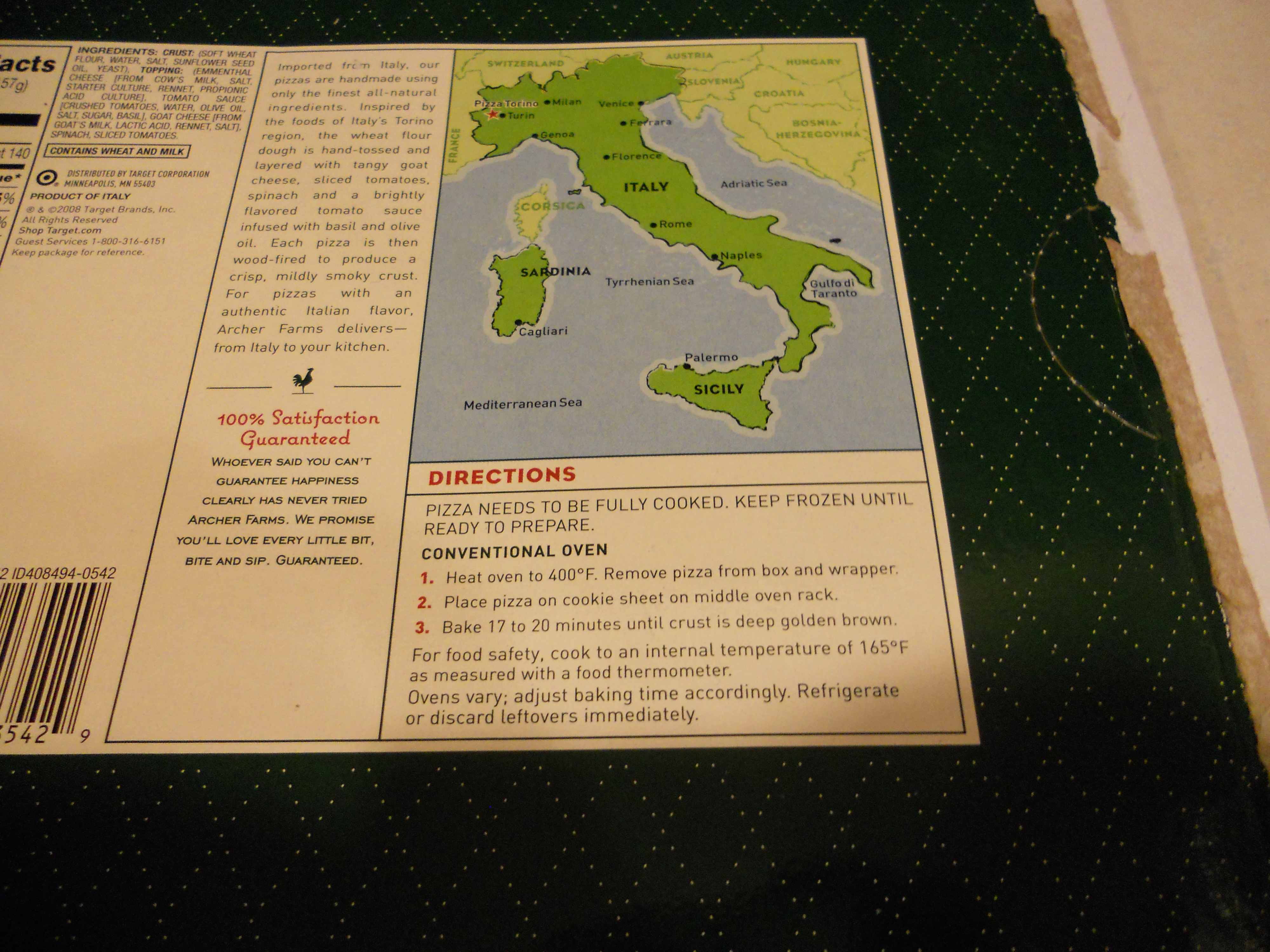 As we all recover from the flu, our appetites are only mediocre. In the spirit of things, I cooked an Archer Farms spinach and goat cheese pizza for dinner tonight. I added olives because that’s one of the few things Sorenne currently loves. When looking at the cooking time and temp I noticed detailed directions that seem straight from this blog:
As we all recover from the flu, our appetites are only mediocre. In the spirit of things, I cooked an Archer Farms spinach and goat cheese pizza for dinner tonight. I added olives because that’s one of the few things Sorenne currently loves. When looking at the cooking time and temp I noticed detailed directions that seem straight from this blog: So I did (exactly as pictured). After cooking the pizza at 400F for about 18 minutes, I took it out and tried to eye the thickest part. Then I tried to put the thermometer in somewhat sideways being careful not to poke through the other side. To take the picture, I had to prop the thermometer on my spatula. The process made a big gash in my pizza toppings and the cheese stuck like glue on the thermometer, but it was easy to see the pizza was well above 165F.
So I did (exactly as pictured). After cooking the pizza at 400F for about 18 minutes, I took it out and tried to eye the thickest part. Then I tried to put the thermometer in somewhat sideways being careful not to poke through the other side. To take the picture, I had to prop the thermometer on my spatula. The process made a big gash in my pizza toppings and the cheese stuck like glue on the thermometer, but it was easy to see the pizza was well above 165F..jpg) the motive and the weapon. The victim had asked Boullard’s female companion to stop talking on a cellphone during the movie.
the motive and the weapon. The victim had asked Boullard’s female companion to stop talking on a cellphone during the movie..jpg) today, with nary a mention of thermometers.
today, with nary a mention of thermometers..jpg) were linked to consuming poultry liver parfait or pâté.
were linked to consuming poultry liver parfait or pâté. .jpg) hot all the way through. The centre should reach a temperature of 70°C for two minutes or the equivalent time and temperature.
hot all the way through. The centre should reach a temperature of 70°C for two minutes or the equivalent time and temperature. .jpg) At 35 minutes I pull it out and check deep thigh temperature with a Comark PDT 300.
At 35 minutes I pull it out and check deep thigh temperature with a Comark PDT 300.
 15-pound turkeys is that the breast was creeping up to 140-150F, while the stuffing and other parts were languishing at 120. Foil over the breast helps, but it’s always a problem;
15-pound turkeys is that the breast was creeping up to 140-150F, while the stuffing and other parts were languishing at 120. Foil over the breast helps, but it’s always a problem; 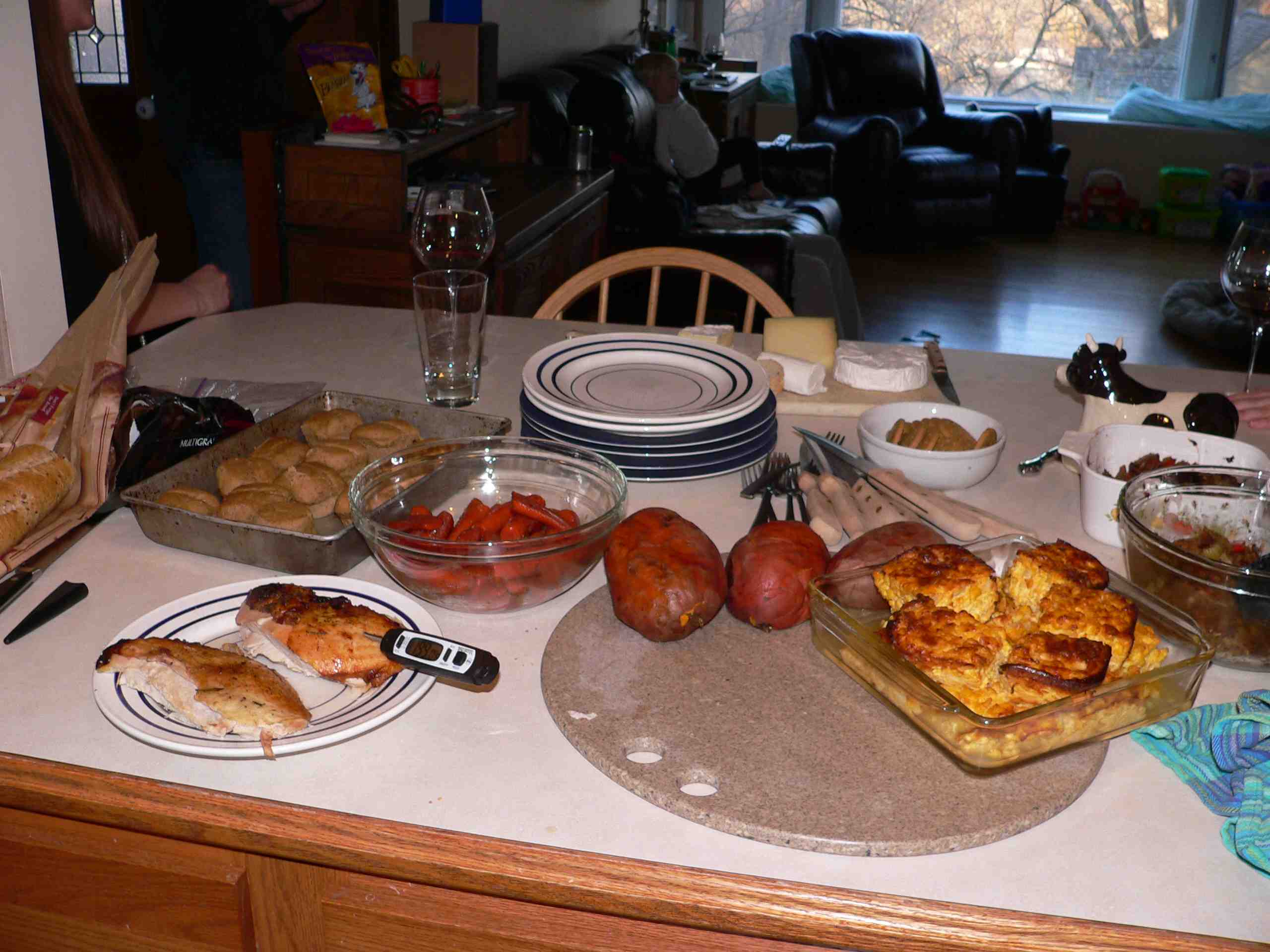 a safe temperature in the microwave. The remainder of the bird went back in the oven.
a safe temperature in the microwave. The remainder of the bird went back in the oven..jpg)
 47F and an interior temperature of 39F (I’ve been letting it sit on the counter to warm up in preparation for cooking).
47F and an interior temperature of 39F (I’ve been letting it sit on the counter to warm up in preparation for cooking).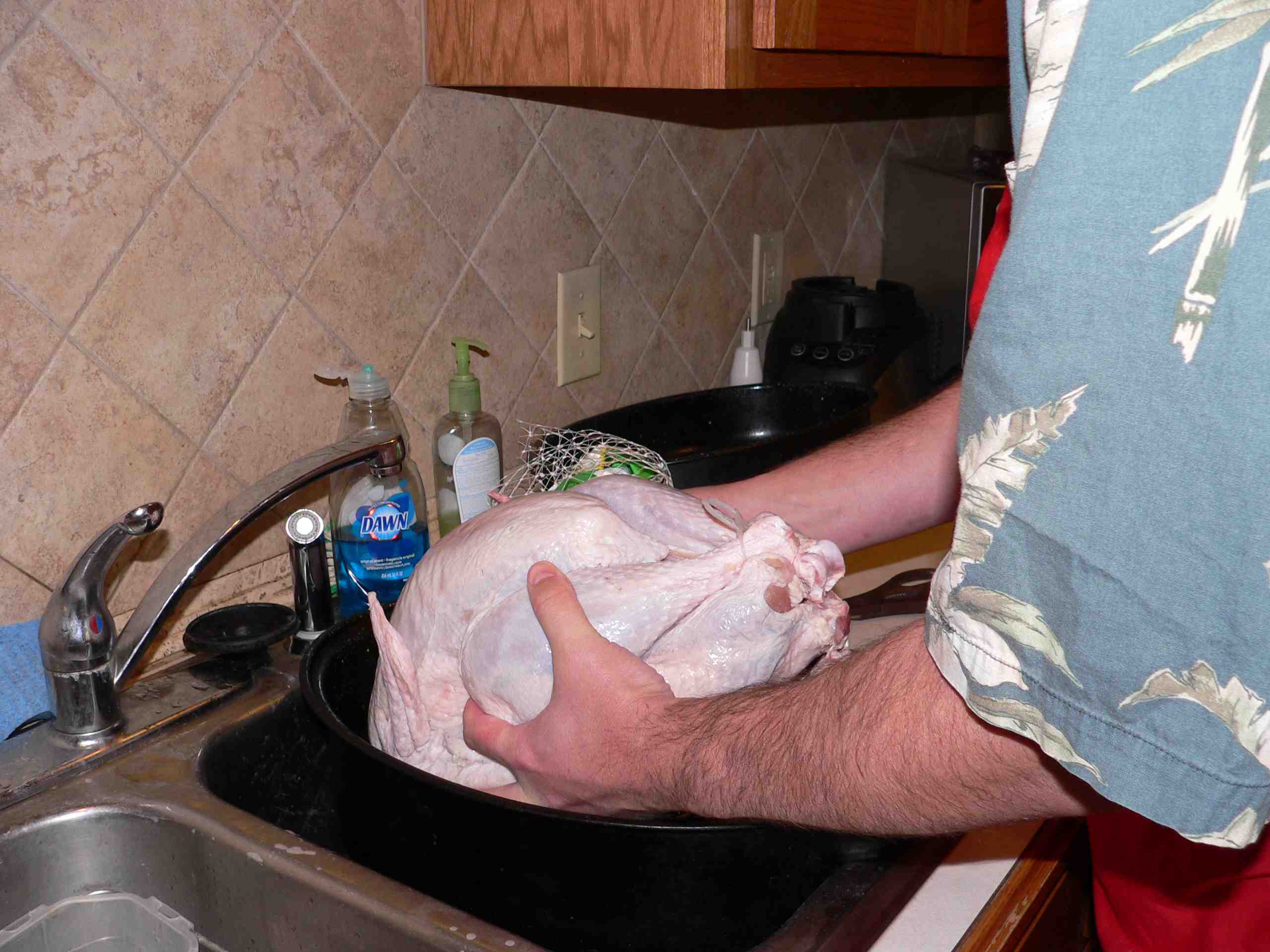 was a package of gravy mix in the cavity, covered in all sorts of bacteria. Got that into its own container, and the neck into the stock pot. Got me and the surrounding area cleaned up.
was a package of gravy mix in the cavity, covered in all sorts of bacteria. Got that into its own container, and the neck into the stock pot. Got me and the surrounding area cleaned up.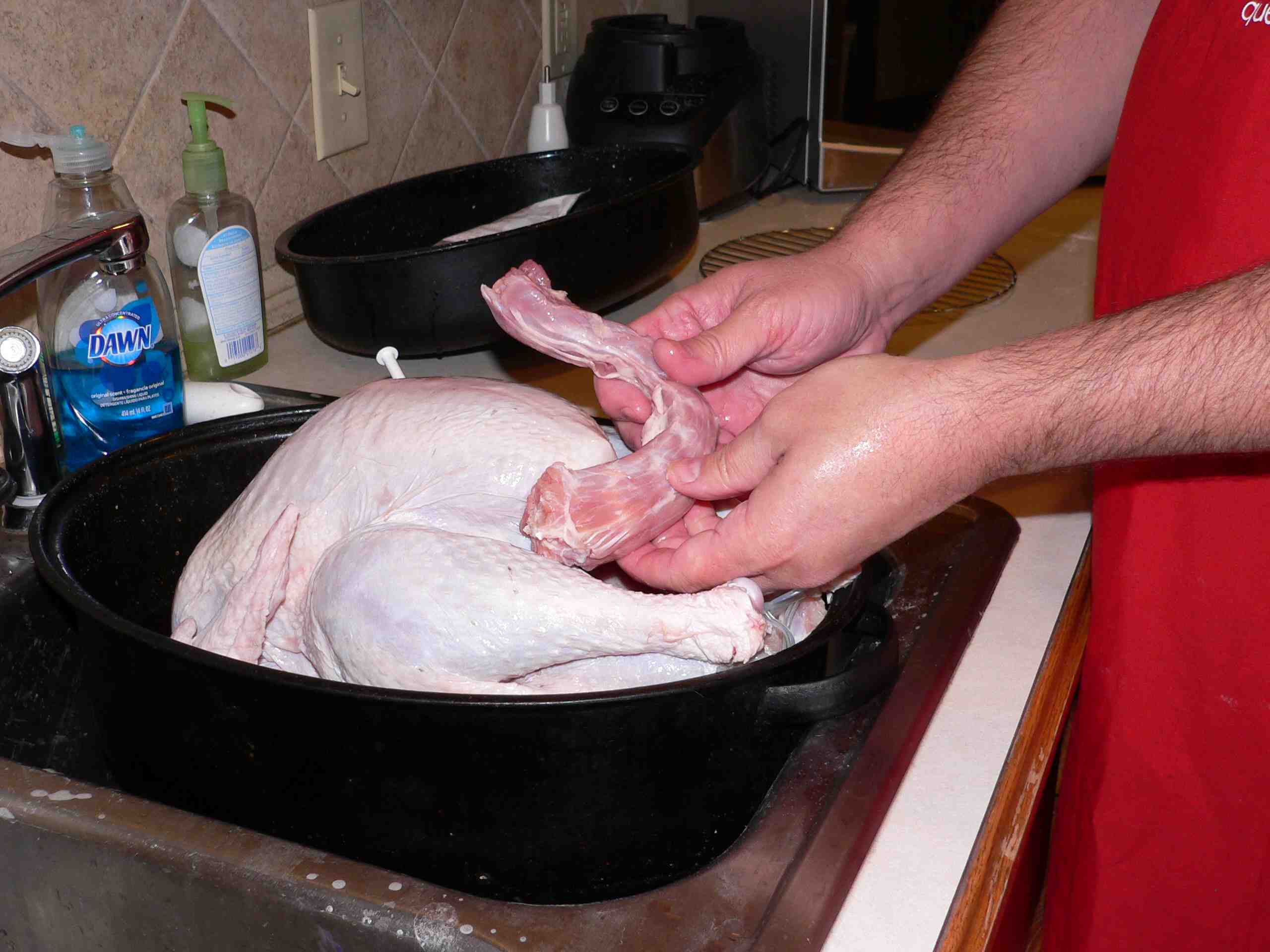

 raw on the inside and burnt on the outside—looked okay to us. That meal was scarfed down by a group of very hungry – and very poor – college students. We knew nothing of food safety, and probably didn’t care.
raw on the inside and burnt on the outside—looked okay to us. That meal was scarfed down by a group of very hungry – and very poor – college students. We knew nothing of food safety, and probably didn’t care. Here’s what I found:
Here’s what I found: at the Butterball Turkey Talk line explained. The placement of a pop-up timer is usually mechanical. This mechanical placement of the pop-up is temperamental – depending on the machines and the turkey placement (they’re slippery when raw!) — so breast, leg or other body parts may be pierced. Variations in the pop-up placement can affect pop-up timing, and presumed temperature. White meat (done at 165ºF-170ºF) cooks quicker than dark meat (where 180ºF is recommended). So instead of including a maybe-not-so-accurate thermometer, Butterball recommends using a probe thermometer to assure proper cooking. The U.S. Department of Agriculture’s meat and poultry hotline, and the Ask Karen online chat had similar information. A pop-up timer is calculated to pop when the breast meat measures about 180 degrees, which is when the leg and thigh area is most likely at the 165 degree temperature. Although pop-up timers are accurate to +/- 2ºF, they recommend verifying temperature of your bird with a thermometer that gives a numeric reading.
at the Butterball Turkey Talk line explained. The placement of a pop-up timer is usually mechanical. This mechanical placement of the pop-up is temperamental – depending on the machines and the turkey placement (they’re slippery when raw!) — so breast, leg or other body parts may be pierced. Variations in the pop-up placement can affect pop-up timing, and presumed temperature. White meat (done at 165ºF-170ºF) cooks quicker than dark meat (where 180ºF is recommended). So instead of including a maybe-not-so-accurate thermometer, Butterball recommends using a probe thermometer to assure proper cooking. The U.S. Department of Agriculture’s meat and poultry hotline, and the Ask Karen online chat had similar information. A pop-up timer is calculated to pop when the breast meat measures about 180 degrees, which is when the leg and thigh area is most likely at the 165 degree temperature. Although pop-up timers are accurate to +/- 2ºF, they recommend verifying temperature of your bird with a thermometer that gives a numeric reading..jpg) awareness, but nothing beats proper use of an appropriate numeric thermometer, and clear, accurate cooking instructions. It would have been safer to have an overcooked entrée masked with gravy, then the food safety disaster I fed to my friends. Thankfully, they survived.
awareness, but nothing beats proper use of an appropriate numeric thermometer, and clear, accurate cooking instructions. It would have been safer to have an overcooked entrée masked with gravy, then the food safety disaster I fed to my friends. Thankfully, they survived.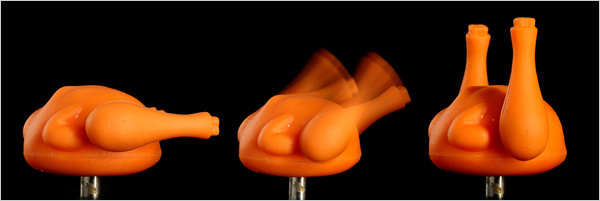 (Poor Canadians, still told to cook to 185F, but that may change to 180F;
(Poor Canadians, still told to cook to 185F, but that may change to 180F;